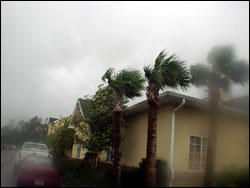Warmer Seas, Wetter Air Make Harder Rains as Greenhouse Gases Build

Storms will dump heavier rain and snow around the world as Earth’s climate warms over the coming century, according to several leading computer models. Now a study by scientists at the National Center for Atmospheric Research (NCAR) explains how and where warmer oceans and atmosphere will produce more intense precipitation. The findings recently appeared in Geophysical Research Letters, a publication of the American Geophysical Union.
The greatest increases will occur over land in the tropics, according to the study. Heavier rain or snow will also fall in northwestern and northeastern North America, northern Europe, northern Asia, the east coast of Asia, southwestern Australia, and parts of south-central South America during the 21st century.
“The models show most areas around the world will experience more intense precipitation for a given storm during this century,” says lead author Gerald Meehl. “Information on which areas will be most affected could help communities to better manage water resources and anticipate possible flooding.”
NCAR authors Meehl, Julie Arblaster, and Claudia Tebaldi analyzed the results of nine atmosphere-ocean global climate models to explain the physical mechanisms involved as intensity increased. Precipitation intensity refers to the amount of rain or snow that falls on a single stormy day.
Both the oceans and the atmosphere are warming as greenhouse gases build in the atmosphere. Warmer sea surfaces boost evaporation, while warmer air holds more moisture. As this soggy air moves from the oceans to the land, it dumps extra rain per storm.
Though water vapor increases the most in the tropics, it also plays a role in the midlatitudes, according to the study. Combined with changes in sea-level pressure and winds, the extra moisture produces heavier rain or snow in areas where moist air converges.
In the Mediterranean and the U.S. Southwest, even though intensity increases, average precipitation decreases. The authors attribute the decrease to longer periods of dry days between wet ones. The heavier rain and snow will most likely fall in late autumn, winter, and early spring, while warmer months may still bring a greater risk of drought.
Media Contact
More Information:
http://www.ucar.eduAll latest news from the category: Ecology, The Environment and Conservation
This complex theme deals primarily with interactions between organisms and the environmental factors that impact them, but to a greater extent between individual inanimate environmental factors.
innovations-report offers informative reports and articles on topics such as climate protection, landscape conservation, ecological systems, wildlife and nature parks and ecosystem efficiency and balance.
Newest articles

Silicon Carbide Innovation Alliance to drive industrial-scale semiconductor work
Known for its ability to withstand extreme environments and high voltages, silicon carbide (SiC) is a semiconducting material made up of silicon and carbon atoms arranged into crystals that is…

New SPECT/CT technique shows impressive biomarker identification
…offers increased access for prostate cancer patients. A novel SPECT/CT acquisition method can accurately detect radiopharmaceutical biodistribution in a convenient manner for prostate cancer patients, opening the door for more…

How 3D printers can give robots a soft touch
Soft skin coverings and touch sensors have emerged as a promising feature for robots that are both safer and more intuitive for human interaction, but they are expensive and difficult…





















